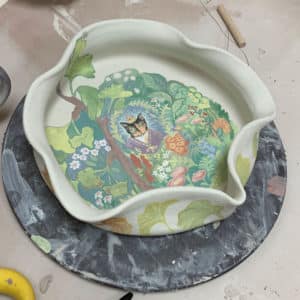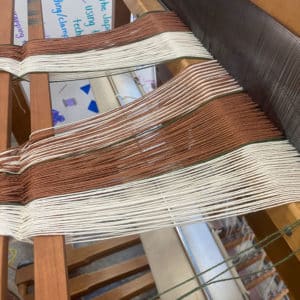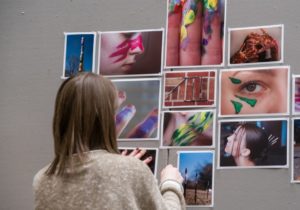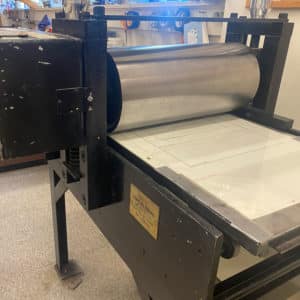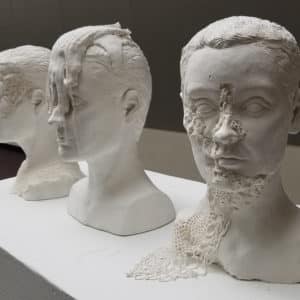Art - BA and BFA: Studio
The Studio Art Program
For the Bachelor of Fine Arts in Studio Art, you can choose from six different studio emphases in ceramics, fibers, painting, photography, printmaking, and sculpture. Focus on one particular studio area or combine two for an inter-specialty option.
Areas of Specialty
Career Paths
Careers in museums and galleries are growing as new institutions in a number of fields open, and old ones add new wings and new community outreach programs. The titles of positions held by such professionals give a sense of the variety of options available: Gallery Director, Museum Curator, Museum Educator, Program Manager, Exhibit Installation Manager, etc. While graduates with the right undergraduate experience (for instance working for our Gallery Director in the University Art Gallery) do gain entry level employment with good hourly wages, a more ambitious route is to pursue graduate education in Art History, Studio Art, Education, or Museum Studies while intentionally focusing one’s research and departmental service experiences towards work in the field. Either way, an undergraduate degree at Truman accompanied by the interdisciplinary Museum Studies Minor is an excellent way to gain exposure to these career paths and prepare for that next step. Alumni working in this field include Mike Murawski, Director of Learning and Community Partnerships at the Portland Art Museum, Jennifer Teter, Executive Director and Curator at the Quincy Art Center, and Samantha Lyons, Assistant Curator at the San Jose Museum of Quilts ad Textiles.
The opportunities to make a living as an artist are often self-created and may depend upon the ability to think of one’s art in terms of a business. Others prefer not to put sales first and use their liberal arts skill sets to work in the arts and culture sector, or go a more entrepreneurial route, while pursuing their art on the side. Owing to its more intensive focus on professional practices and on one particular art medium, the BFA degree is more appropriate to this career path than is the BA. Some media more naturally lead to careers creating in the medium of choice – as for example our Ceramics alumni have become professional potters and our Photography alumni have become professional photographers. Other alumni work in a wide variety of careers practicing their craft including as muralists, work in print shops, own their own fiber arts studios, or create public sculptures.
Here are websites of several of these talented artists pursuing their passion:
lorinix.net
dustyfolwarczny.com
bethcampbellstudio.com
ayers-pottery.myshopify.com
violatextiles.com
meganklco.com
galengibsoncornell.com
To work as a licensed art therapist, which also includes more general therapy certification, you will need a graduate degree in Art Therapy. The art therapy graduate degree is a reliable way of gaining Master’s level employment in a clinical setting, either with the title of Art Therapist or in another role where one’s art therapy skills can be put to use. For most of those graduate programs an undergraduate degree in Art, plus a selection of psychology and statistics courses, is the best preparation. Because of that extra coursework we would generally recommend pursuing our BA degree, which allows for more flexibility in one’s course schedule than the BFA. Contacts in the field, such as Truman alum Megan Robb, Director of the Art Therapy graduate program at Southern Illinois University – Edwardsville, recommend one seek out experience working in an environment where clinical practice takes place, or with a population receiving therapeutic services. A well written personal statement, and a portfolio of artwork demonstrating expressive communication, rather than simply strong technical skills, are also important parts of the graduate application.
Graphic Design at Truman is a high tech, digital field with education in the professional aesthetics, design theory, and the technology that designers utilize. It is an area of study that is strengthened by Truman State University’s Liberal Arts mission. Graphic Designers shape and influence society through their creative concepts, on-target messaging, expressive visuals, and innovative designs seen my million of people every day.
Designers from Truman are highly employable due to their skills and knowledge across disciplines and their professional preparation.
Our alumni work as…
Business Owners
Creative Directors
Art Directors
Graphic Designers
Web Designers
Web Developers
UX/UI Designers
Production Artists
2D and 3D Asset Developers
Motion Artists and Animators
Freelance Designers
Illustrators
Depending upon interests and area focus, graphic design majors have career opportunities in…
Advertising and Marketing Agencies
Public Relations Firms
Publishing Companies – book and/or periodicals
Commercial Printing
Corporate In-house Creative Teams
Internet-based Communications
Television and Broadcast Companies
Animation/Motion studios
Entertainment industry
Here are a number of our alumni’s professional websites in the graphic design field:
Anna Pavan 2019: JSL Marketing and Web Design
Josh Fakler 2019: Cannonball
Claire Nipper 2018: Origin Agency
Rose Linhares 2017: Atomic Dust
Lauren Jin 2017: New Balance
Brandon Ribbs 2018: RL/D Creative
Jenny Cross 2012: TwoTone Creative
Reina Koyano 2012: Snap Inc.
Megan Irwin 2006: Cheree Berry Paper
James Wagner 2000: Lagom Design
Interested in teaching art? We currently offer two pathways to an Art Certification. One is through the MAE in Elementary Education and the other is through the MAE in Special Education – either one of those being paired with a BA in Art. The combination of the undergraduate degree followed by a master’s degree (one-year program if you plan early), complemented by observation hours in an art classroom and certified by taking the DESE content exams, provides an outstanding preparation for teaching in elementary education, special education and/or art education.
All of our instructors at Truman have a wealth of knowledge about this rewarding field. Teaching at the college level requires a Master’s degree and often, as with all Truman faculty, a terminal degree such as the MFA or PhD is required. It is also a field that requires and rewards an ongoing creative practice, which is one reason many artists are drawn to academia. Those interested in teaching Art History will want to pursue that concentration in our BA degree, while those interested in fine art or graphic design are best served by the BFA option. Like many fields, higher education has been disrupted and is evolving due to changing demographics, changing demands from society, and the possibilities and pitfalls of the internet. The college professor of the future will need to be able to adapt to that changing environment just as today’s successful college professor has a different set of skills and dispositions than was the case a couple of decades ago. Alumni working in this filed include Alexander Thierry, Assistant Professor of Ceramics and Art Education at South Carolina State University, Linh T. Dao, Assistant Professor in the Art & Design Department at California Polytechnic State University, and Dr. Jasmine Cloud, Associate Professor at the University of Central Missouri.
Truman Art alums frequently create their own dream job. They found their own businesses providing products and services that the world didn’t yet know it needed. Whether they are using their drawing skills to help fortune 500 companies visualize their mission, starting up their own pottery studio where the public can create their own or purchase the owner’s one-of-a-kind ceramics, or going out on their own as a freelance illustrator and lettering expert – these former students are creating their own niche in the cultural economy.
Many of the websites listed in previous headings could also fit here, but these are websites of a couple of other arts sector businesses founded by our alumni:
Part of the point of getting a liberal arts education is being prepared for whatever life path you find yourself on. Adding creative skills to the basic set of research, writing, oral communication, and critical thinking skills makes our graduates valuable to virtually any organization. Our alums have a wide variety of careers both in and out of the cultural sector. They are lawyers, medical professionals, community activists, non-profit professionals, fundraisers, civil servants, small business owners, and so much more.
Art Student Resources
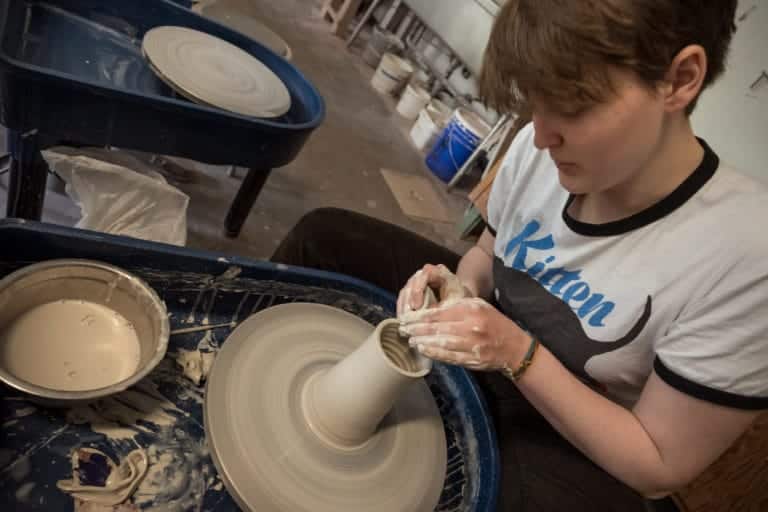
Art Studios
As an art major, you spend significant amounts of time in the various art studios for ceramics, fibers, painting, photography, printmaking, and sculpture.

Student Organizations
If you're interested in studio art, you might be especially qualified for the printmaking, ceramics, and fibers clubs.

